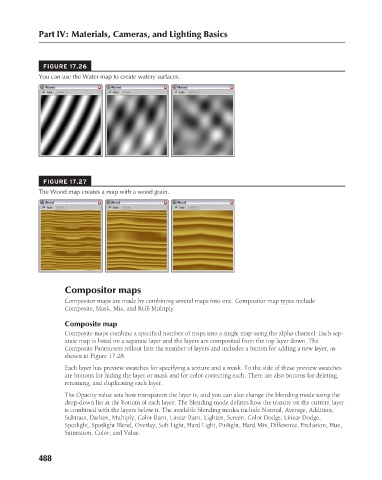Page 536 - Kitab3DsMax
P. 536
Part IV: Materials, Cameras, and Lighting Basics
FIGURE 17.26
You can use the Water map to create watery surfaces.
FIGURE 17.27
The Wood map creates a map with a wood grain.
Compositor maps
Compositor maps are made by combining several maps into one. Compositor map types include
Composite, Mask, Mix, and RGB Multiply.
Composite map
Composite maps combine a specified number of maps into a single map using the alpha channel. Each sep-
arate map is listed on a separate layer and the layers are composited from the top layer down. The
Composite Parameters rollout lists the number of layers and includes a button for adding a new layer, as
shown in Figure 17.28.
Each layer has preview swatches for specifying a texture and a mask. To the side of these preview swatches
are buttons for hiding the layer or mask and for color correcting each. There are also buttons for deleting,
renaming, and duplicating each layer.
The Opacity value sets how transparent the layer is, and you can also change the blending mode using the
drop-down list at the bottom of each layer. The blending mode defines how the texture on the current layer
is combined with the layers below it. The available blending modes include Normal, Average, Addition,
Subtract, Darken, Multiply, Color Burn, Linear Burn, Lighten, Screen, Color Dodge, Linear Dodge,
Spotlight, Spotlight Blend, Overlay, Soft Light, Hard Light, Pinlight, Hard Mix, Difference, Exclusion, Hue,
Saturation, Color, and Value.
488
6/30/10 4:25 PM
25_617779-ch17.indd 488 6/30/10 4:25 PM
25_617779-ch17.indd 488

